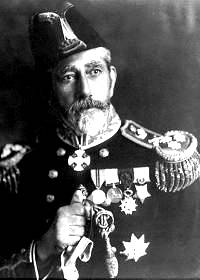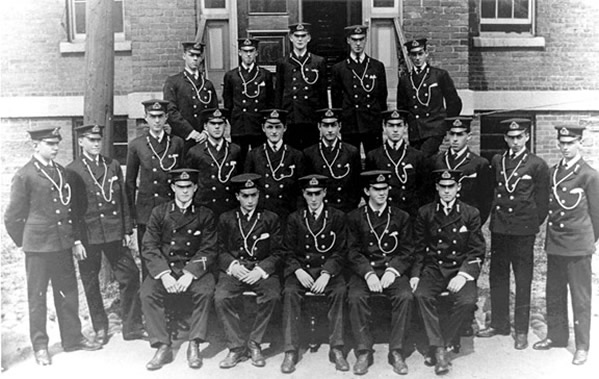Timeline: 1910-1919
A Canadian Navy is Born
|
1910-1919
|
|||||||||||||||||
|
|||||||||||||||||
The Canadian Navy was formed from the Naval Service Act which came into effect on 4 May 1910.
The first order of business was to recruit sailors and also to provide ships and training facilities. The personnel for the newly created service were obtained partly in Canada and partly by borrowing from the RN.
The first Director of the Naval Service was Rear-Admiral Charles Edmund Kingsmill (1855 - 1935), who was born at Guelph, Ontario.

The first Director of the Naval Service was Rear-Admiral Charles Edmund Kingsmill.
In 1870 Charles Kingsmill joined as a midshipman in the RN. He was promoted Sub-lieutenant in 1875, Lieutenant in 1877, Commander in 1891, and Captain in 1898. In 1908 he retired with the rank of Rear-admiral and came to Canada to command the Marine Service of the Department of Marine and Fisheries. He was knighted in 1918.
In July 1910, within weeks of the creation of a Naval Service in Canada, the new Director headed off to England to attend trials of two cruisers, the NIOBE and the RAINBOW.
On the 4th of Aug 1910, HMCS RAINBOW commissioned into the Canadian Naval Service. HMCS RAINBOW arrived at her home port of Esquimalt on the 7th of Nov, 1910
On the 6th of Sept 1910, HMCS NIOBE commissioned into the Canadian Naval Service at Devonport. Cdr. W.B. Macdonald RN, a native of BC, was placed in command of the NIOBE. HMCS NIOBE arrived at her home port of Halifax on the 21st of Oct, 1910.
In
Oct 1910, HM King George V graciously allowed the use of “Royal”
in name of Naval College of Canada, which received the honour before
the Royal Canadian Navy itself did.
On the 9th of Nov, 1910, the naval base at Esquimalt passed from British to Canadian hands
In the fiscal year of 1910 / 1911, the number of Cadets entering Naval Service was 28, the number of RCN officers and ratings was 704 total, and the projected naval expenditure as $1,790,017.00
On the 30th of Jan 1911, HM King George V graciously allowed the use of “Royal” in name of Canadian Navy, and the abbreviation became RCN.
In Jun 1911, Cdr (later Rear-admiral) Walter Hose (1875 - 1965) was lent to the Canadian Naval Service and assumed command of HMCS RAINBOW.
Born at sea in 1875, he had entered the Royal Navy in 1890. He served in many parts of the world, including the waters of Newfoundland, where he met and married a native of St. John’s. In 1912, he retired from the RN and joined the Canadian Naval Service. He commanded RAINBOW until 1917, when he was transferred to Ottawa to organize the east coast patrols, where he was later appointed Captain of Patrols.
In the fiscal year of 1911 / 1912, the number of Cadets entering Naval Service was 10, the number of RCN officers and ratings was 695 total, and the projected naval expenditure as $1,233,456.00. In the fiscal year of 1912 / 1913, the number of Cadets entering Naval Service was 9, the number of RCN officers and ratings was 592 total, and the projected naval expenditure as $1,085,660.00
In July 1913, the first naval volunteer force (unofficial) in Canada, the Victoria Volunteers, was established. However, in the non-volunteer organization, the story was not as bright. In the fiscal year of 1913 / 1914, the number of Cadets entering Naval Service had dropped to 4, the number of RCN officers and ratings was now only 330 total, and the projected naval expenditure a mere $597,556.00.
By May 1914 the establishment of a Naval Volunteer Force had been confirmed by an Order-in-Council. Three subdivisions were ordered with a total strength of 1,200 men. Annual cost estimated at $200,000.00. From the outset it was called the Royal Naval Canadian Volunteer Reserve (RNCVR).

Midshipmen, Royal Naval College, Halifax, N.S.
